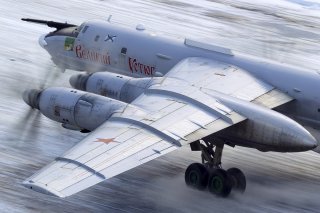Russia and China's Bombers Just Showed Their Power in Asia
This development seems to correspond with what is now a large-scale Japanese military build-up that includes the purchase of new F-35 jets, work on a sixth-generation aircraft or an F-35-F-22 type hybrid aircraft and increased training patrols in the region.
The Russians and the Chinese recently conducted a massive joint collaborative strategic bomber patrol in a show of mutual solidarity, a large-scale development likely to receive attention at the Pentagon. The actual extent of Russian-Chinese military-to-military cooperation may not be fully known, however, this exercise is believed to be somewhat larger than previous joint patrols.
A report in the Chinese government-backed Global Times newspaper states that China participated with four H6-K bomber aircraft while Russia flew two Tu-95 bomber aricraft. These platforms are similar to the mission scope of U.S. bomber aircraft, intended to hold potential enemies at risk from high altitudes with both nuclear and conventional precision-guided, air-dropped weapons.
“The warplanes formed a formation and patrolled the Sea of Japan and the East China Sea,” the paper reports. The paper goes on to state that “the fact that both two strategic patrols chose the Sea of Japan and the East China Sea indicated that China and Russia have constant and common concerns on the strategic stability in these regions.”
The report also explained that more joint patrols, likely of an even bigger scale, are “set for the future.”
Certainly, any kind of joint Russian-Chinese attack would present new levels of risk to the United States. It’s notable that this development seems to correspond with what is now a large-scale Japanese military build-up that includes the purchase of new F-35 jets, work on a sixth-generation aircraft or an F-35-F-22 type hybrid aircraft and increased training patrols in the region.
A separate report in the Global Times states that China is not concerned about Japan’s growing defense budget.
“Chinese military experts said on Tuesday that the recent increase in Japan's defense budget for a ninth straight year will not pose any actual threat to China, as Japan is still intimidated by the strong, all-round military competitiveness of its neighbor, and is unlikely to make audacious moves toward China,” the paper said. Specifically, the report cites Japan’s record $51.6 billion defense budget which, the paper claims, will substantially increase longer-range missiles for new remote attack abilities.
The prospect of any kind of major engagement against a combined Russian and Chinese force is certainly likely to raise alarm bells among U.S. military leaders, but it is not clear that even a combined force such as this could truly rival the United States, Japan, NATO and other allied forces potentially united against such a threatening alliance. Also, perhaps of even greater significance, even large scale joint training exercises and bomber patrols do not assure there is any kind of an operational alliance or strategic alignment sufficient to pose a very serious threat to the U.S. and its allies.
A combined Russian-Chinese attack force would certainly increase the reach of the attack, however, the actual extent of the threat would seem to most likely hinge upon the relative success with which the two major powers could share information, interoperate or align operational tactics with one another. Victory in any kind of modern, large-scale engagement would certainly, at least in part, be determined by force size, weapons range and overall technological military sophistication, yet bringing those attributes to fruition in war would rest upon an ability to network.
The degree of Russian-Chinese operational networking potential may simply not be known, yet something of this kind does rely upon a need for common standards, protocols, frequencies or, in some cases, certain kinds of joint computer processing technology. Effective strike ranges, sensing ranges and node-to-node and force-wide intelligence sharing would likely provide the margin of difference in any kind of massive warfare.
Kris Osborn is the defense editor for the National Interest. Osborn previously served at the Pentagon as a Highly Qualified Expert with the Office of the Assistant Secretary of the Army—Acquisition, Logistics & Technology. Osborn has also worked as an anchor and on-air military specialist at national TV networks. He has appeared as a guest military expert on Fox News, MSNBC, The Military Channel, and The History Channel. He also has a Masters Degree in Comparative Literature from Columbia University.
Image: Reuters

